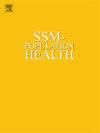The use of solitary confinement and in-custody mortality in North Carolina State Prisons, 2021–2023
IF 3.1
2区 医学
Q1 PUBLIC, ENVIRONMENTAL & OCCUPATIONAL HEALTH
引用次数: 0
Abstract
Purpose
Solitary confinement is associated with increased mortality post-release. Little is known about its use following recent reforms and COVID-19 challenges, and its association with in-custody deaths. We investigated patterns of and associations between solitary confinement and mortality in North Carolina (NC) state prisons.
Methods
Using weekly housing data from Disability Rights NC, we created a retrospective cohort of those newly incarcerated in NC prisons between 2021 and 2023. We calculated the weekly proportion of individuals experiencing solitary confinement for 2+ weeks by type (e.g., administrative purposes). We calculated all-cause mortality rates stratified by those who did and did not experience solitary confinement.
Results
Nearly one-quarter of 41,525 individuals in NC state prisons experienced solitary confinement. By the end of follow-up, over 6.0 % of individuals were in solitary confinement per week, and there were 43 in-custody deaths. Those who never experienced solitary confinement had an all-cause mortality rate of 1.96 per 100,000 person-weeks (95 % CI: 1.32, 2.82), and those who experienced solitary confinement had an all-cause mortality rate of 4.23 per 100,000 person-weeks (95 % CI: 2.31, 7.09).
Conclusions
Solitary confinement is common in NC prisons and is associated with elevated death rates in custody. There is an urgent need to document the types and duration of solitary stays to ultimately end this punitive practice.
2021-2023年北卡罗来纳州监狱单独监禁的使用和在押死亡率
单独监禁与释放后死亡率增加有关。在最近的改革和COVID-19挑战之后,人们对其使用情况及其与在押人员死亡的关系知之甚少。我们调查了北卡罗来纳州监狱单独监禁与死亡率之间的模式和关联。方法利用残疾人权利委员会的每周住房数据,我们对2021年至2023年间在残疾人权利委员会监狱新入狱的人进行了回顾性队列研究。我们按类型(如行政目的)计算了每周单独监禁2周以上的个人比例。我们按单独监禁和未单独监禁的人计算了全因死亡率。结果在北卡罗来纳州监狱的41525人中,有近四分之一的人经历过单独监禁。到随访结束时,每周有超过6.0%的人被单独监禁,有43人在监禁中死亡。从未经历过单独监禁的患者的全因死亡率为每10万人周1.96例(95% CI: 1.32, 2.82),而经历过单独监禁的患者的全因死亡率为每10万人周4.23例(95% CI: 2.31, 7.09)。结论:单独监禁在美国监狱中很常见,并与监禁期间死亡率升高有关。迫切需要记录单独监禁的类型和持续时间,以最终结束这种惩罚性做法。
本文章由计算机程序翻译,如有差异,请以英文原文为准。
求助全文
约1分钟内获得全文
求助全文
来源期刊

Ssm-Population Health
PUBLIC, ENVIRONMENTAL & OCCUPATIONAL HEALTH-
CiteScore
6.50
自引率
2.10%
发文量
298
审稿时长
101 days
期刊介绍:
SSM - Population Health. The new online only, open access, peer reviewed journal in all areas relating Social Science research to population health. SSM - Population Health shares the same Editors-in Chief and general approach to manuscripts as its sister journal, Social Science & Medicine. The journal takes a broad approach to the field especially welcoming interdisciplinary papers from across the Social Sciences and allied areas. SSM - Population Health offers an alternative outlet for work which might not be considered, or is classed as ''out of scope'' elsewhere, and prioritizes fast peer review and publication to the benefit of authors and readers. The journal welcomes all types of paper from traditional primary research articles, replication studies, short communications, methodological studies, instrument validation, opinion pieces, literature reviews, etc. SSM - Population Health also offers the opportunity to publish special issues or sections to reflect current interest and research in topical or developing areas. The journal fully supports authors wanting to present their research in an innovative fashion though the use of multimedia formats.
 求助内容:
求助内容: 应助结果提醒方式:
应助结果提醒方式:


